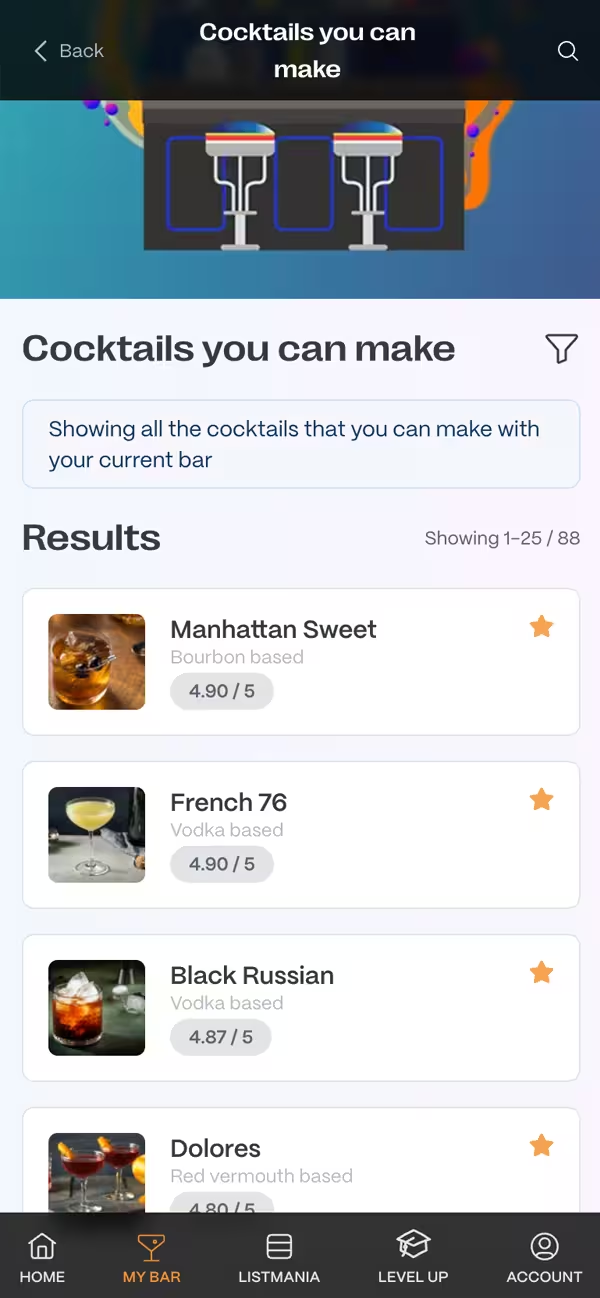The Crack Baby cocktail might not yet be considered a classic, but it has already secured its place...
Shaking: The Hows and Whats
Jump to
- The Basics
- The Hard Shakes
- The Overhead Shake
- The Japanese Hard Shake
- The Soft Shake
- The Bull
- The One-Hander
A cocktail shaker's basic function is to quickly cool the drink by mixing it with ice. But professionals know that shaking a drink is about much more than cooling it down. A mixologist's shake is a bit of theater, entertainment for his customers and a way to stamp his personal style on his mixing technique.
The Basics
Fill the cocktail shaker two-thirds to three-quarters of the way full with ice cubes, not crushed ice. Pour the ingredients in in descending order of alcohol content. Place the top onto the shaker and tap it down with the heel of your hand to ensure a good seal between the two parts of the shaker. Each shake must continue for 15 seconds or until frost develops on the outside of the shaker.
The Hard Shakes
Hard shakes use rapid, short movements to achieve maximum cooling over the shortest amount of time. Hard shakes are the most efficient mixing shakes. Hard shakes are ideal for cocktails with heavy ingredients like cream, egg whites or syrups. Hard shakes are also ideal for cocktails that you want to serve slightly frothy and aerated. Because the ice takes the most abuse during a hard shake, the bigger the ice cubes the better.
The Overhead Shake
This hard shake requires confidence in your seal or you'll end up wearing the cocktail in your hair. Hold each end of the cocktail shaker in the palm of each hand with your fingers gripping the sides where they fall naturally. Hold the shaker horizontally overhead and shake it rapidly front to back. This technique is also ideal if the bar is busy and you have to allow room for other passing bartenders.
The Japanese Hard Shake
This hard shake is considered the best among the old school seasoned professionals. Hold each end of the cocktail shaker in the palm of each hand with your fingers gripping the sides where they fall naturally. Hold the cocktail shaker at eye level. Hold it vertically for a classic Japanese hard shake. Hold it at a 45 degree angle for the Ginza hard shake. Shake the cocktail shaker up and down rapidly with little range of motion. While you shake, move the shaker slowly up and down between your breast bone and the top of your head.
The Soft Shake
The soft shake is mellower than the hard shake. Instead of short movements that shake the ice as hard as possible, soft shakes move just enough to hit the ice on either end of the shaker. Soft shakes are ideal for cocktails with light ingredients that could be stirred but are preferred shaken.
The Bull
This is a big soft shake with an aggressive personality and a lot of flair. Hold each end of the cocktail shaker in the palm of each hand with your fingers gripping the sides where they fall naturally. Hold the cocktail shaker vertically. Lift it above your head. Swing it down to belly button level. Repeat as quickly as you can manage while maintaining a large range of motion.
The One-Hander
This soft shake requires a lot of confidence in your seal much like the overhead shake. Grip the shaker around the seal where the top and bottom of the shaker mix. Hold the shaker at a 45 degree angle. Shake the shaker gently back and forth using your wrist to create the shaking motion. Keep the movement gentle, just enough to hear the ice move inside.
Pardon the interruption
Did you know that you can become a member for free, taking your cocktail making skills up to level 11. You can save your My Bar ingredients, make tasting notes, have personalised Tried and Want to try lists and more.
Filed with tags
More to explore
The Old Fashioned cocktail is a timeless classic that has become synonymous with sophistication and...
The Cosmopolitan, a stylish pink concoction in a martini glass, was the signature cocktail in the 19...
Tag cloud
Explore more with our randomised tag cloud.
-
Sci-Fi
-
Hot Toddy
-
Vibrant Color
-
Quick Sip
-
Evenings
-
Easy-to-Prepare
-
Cocktail Origins
-
Dark Rum
-
Medieval
-
Summer Getaways
-
Young Adults
-
Contest
-
Liqueur-based
-
Luxurious Cocktails
-
Alcohol Culture
-
Easy Sipping
-
Experimental
-
Cachaça
-
Movies
-
French Influence
Bartender's top tip
Related posts
The Definitive Guide to Mastering the Iconic Whiskey Sour Cocktail
Ah, the Whiskey Sour – a timeless classic that has graced bars and cocktail lounges for over 150 years. This iconic drink is a perfect balance of sweet, tart, and boozy flavors, making it a crowd-plea... read more
Tequila….. The New Unexpected Star of Your Festive Cocktails This Year
Not us! While tequila often takes centre stage during poolside parties and beach vacations (hello fellow Margarita!), it's time to rethink its seasonal limitations. This versatile spirit can add a fes... read more
Ginger Ale vs. Ginger Beer: The Main Differences
Ginger beverages have been around for centuries, and while they share a common ingredient—ginger—they are distinct in flavor, production, and use. Whether you’re mixing up a cocktail or simply seeking... read more
Subscribe to our Newsletter
Get tips straight into your inbox.
Upgrade your mixology
Become a member for free taking your cocktail making skills up to level 11. Or become a premium member to rise to cocktail greatness.
- Save your bar forever
- Access to our Cocktail Creator, allowing you to create your own wonderful concoctions.
- Create personalised cocktail menus for all your events, bars or parties
- Save cocktails to personalised 'Tried' and 'Want to try' lists
- Create and record tasting notes on cocktails
- Create lists of cocktails to share with friends and family
- A personalised MyBar URL, allowing you to share everything you can make with friends
- And much more ... (what to buy next, measurement choices, search personalisation...)
Have you tried our Wordpress Plugin?
Download our plugin and embed cocktail recipes directly onto your own site or blog.
Choose from our whole recipe database, or choose a specific cocktail made with a certain ingredient, and let us place a beautiful recipe on your own site.
Find out more



